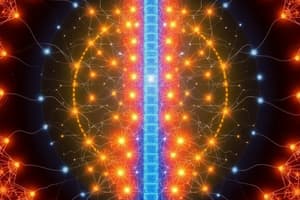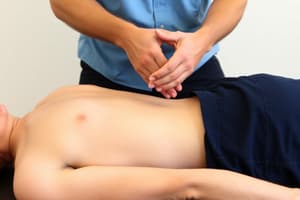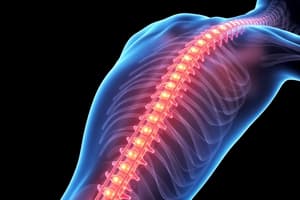Podcast
Questions and Answers
The motor system's hierarchical organization involves the cortex, brainstem, and spinal cord, where the cortex is the highest authority in motor command.
The motor system's hierarchical organization involves the cortex, brainstem, and spinal cord, where the cortex is the highest authority in motor command.
True (A)
Spinal reflexes require continuous input from cortical signals to function effectively.
Spinal reflexes require continuous input from cortical signals to function effectively.
False (B)
All reflexes are innate and remain unchanged throughout a person's life.
All reflexes are innate and remain unchanged throughout a person's life.
False (B)
Reflex actions in the body are characterized by being slow, non-stereotyped, and voluntary.
Reflex actions in the body are characterized by being slow, non-stereotyped, and voluntary.
The spinal cord contains circuits for complex functions alongside motoneurons and sensory neurons.
The spinal cord contains circuits for complex functions alongside motoneurons and sensory neurons.
Sensory-motor neurons of the head and neck originate solely from the cervical part of the spinal cord.
Sensory-motor neurons of the head and neck originate solely from the cervical part of the spinal cord.
The pupillary reflex is an example of a complex reflex that does not have a predetermined response.
The pupillary reflex is an example of a complex reflex that does not have a predetermined response.
Increases in motor control often result in some reflexes being inhibited as individuals mature.
Increases in motor control often result in some reflexes being inhibited as individuals mature.
Reflexes can only be classified based on proprioceptive stimuli.
Reflexes can only be classified based on proprioceptive stimuli.
Decerebrate animal models are used to study reflexes by disconnecting the spinal cord from the CNS.
Decerebrate animal models are used to study reflexes by disconnecting the spinal cord from the CNS.
Alpha motor neurons are responsible for the excitation of intrafusal muscle fibers.
Alpha motor neurons are responsible for the excitation of intrafusal muscle fibers.
The stretch reflex involves the stretching of the quadriceps muscle through a hammer strike on the patellar tendon.
The stretch reflex involves the stretching of the quadriceps muscle through a hammer strike on the patellar tendon.
There are generally 5 types of elements in the reflex arc.
There are generally 5 types of elements in the reflex arc.
Intrafusal fibers are larger than extrafusal skeletal muscle fibers.
Intrafusal fibers are larger than extrafusal skeletal muscle fibers.
The reflex arc includes the integration of signals solely within the brain.
The reflex arc includes the integration of signals solely within the brain.
Gamma motor neurons play a critical role in maintaining muscle tone.
Gamma motor neurons play a critical role in maintaining muscle tone.
The primary sensory nerve endings are known as Ia and are excited by both nuclear bag and nuclear chain fibers.
The primary sensory nerve endings are known as Ia and are excited by both nuclear bag and nuclear chain fibers.
The secondary ending (II) is primarily excited by nuclear bag fibers.
The secondary ending (II) is primarily excited by nuclear bag fibers.
The static response of the spindle receptor occurs when the receptor portion is stretched slowly, and the impulse transmission increases for only a short period.
The static response of the spindle receptor occurs when the receptor portion is stretched slowly, and the impulse transmission increases for only a short period.
The primary ending responds dynamically to the rate of change in spindle receptor length, while the secondary ending does not.
The primary ending responds dynamically to the rate of change in spindle receptor length, while the secondary ending does not.
Gamma motor neurons primarily modulate the dynamic response of the muscle spindle without affecting the static response.
Gamma motor neurons primarily modulate the dynamic response of the muscle spindle without affecting the static response.
The static response of muscle spindle receptors decreases immediately when the receptor length stops increasing.
The static response of muscle spindle receptors decreases immediately when the receptor length stops increasing.
Both primary and secondary sensory endings transmit signals equally well during quick stretches of the spindle receptor.
Both primary and secondary sensory endings transmit signals equally well during quick stretches of the spindle receptor.
A fraction of a micrometer change in the length of the spindle receptor can lead to a significant increase in impulses from the primary receptor.
A fraction of a micrometer change in the length of the spindle receptor can lead to a significant increase in impulses from the primary receptor.
Flashcards
Primary sensory nerve (Ia) ending
Primary sensory nerve (Ia) ending
Excited by nuclear bag and nuclear chain fibers, responding to changes in muscle length.
Secondary ending (II)
Secondary ending (II)
Usually excited only by nuclear chain fibers, responds to muscle length.
Static response
Static response
Response of the spindle receptor to sustained stretching, continuous for minutes.
Dynamic response
Dynamic response
Signup and view all the flashcards
Gamma motor neurons
Gamma motor neurons
Signup and view all the flashcards
Gamma-dynamic (gamma-d)
Gamma-dynamic (gamma-d)
Signup and view all the flashcards
Gamma-static (gamma-s)
Gamma-static (gamma-s)
Signup and view all the flashcards
Role of muscle spindles
Role of muscle spindles
Signup and view all the flashcards
Independent spinal cord
Independent spinal cord
Signup and view all the flashcards
Motor units
Motor units
Signup and view all the flashcards
Hierarchical motor system
Hierarchical motor system
Signup and view all the flashcards
Spinal reflex
Spinal reflex
Signup and view all the flashcards
Features of reflexes
Features of reflexes
Signup and view all the flashcards
Innate reflexes
Innate reflexes
Signup and view all the flashcards
Sensory neurons
Sensory neurons
Signup and view all the flashcards
Interneurons
Interneurons
Signup and view all the flashcards
Reflex Arc
Reflex Arc
Signup and view all the flashcards
Peripheral Receptor
Peripheral Receptor
Signup and view all the flashcards
Integrating Centre
Integrating Centre
Signup and view all the flashcards
Stretch Reflex
Stretch Reflex
Signup and view all the flashcards
Alpha Motor Neurons
Alpha Motor Neurons
Signup and view all the flashcards
Muscle Spindle
Muscle Spindle
Signup and view all the flashcards
Proprioceptive Stimulus
Proprioceptive Stimulus
Signup and view all the flashcards
Study Notes
Spinal Reflexes
- Motor units are the final common path, activating skeletal muscles
- Motor systems are organized hierarchically (spinal cord, brainstem, cortex)
- Cortex dictates when spinal cord circuits operate
- Spinal cord has independent activity (reflexes, automatic movements like locomotion)
- Spinal cord contains sensory, motor, and interneurons
- Brainstem is involved in head/neck sensory-motor functions
- Reflexes are involuntary, stereotyped, fast, and innate responses to external/internal stimuli
Reflexes
- Involuntary responses to stimuli
- Stereotyped responses (same response each time)
- Fast responses due to localized circuits
- Innate responses (present at birth)
Muscle Spindle
- The stretch reflex is assessed by tapping the patellar tendon
- Sensory receptors stretch the quadriceps muscle
- Sensory nerve fibers (1a) respond to stretch
- Primary (1a) and secondary (II) endings respond to stretch
- Primary endings (1a) are rapidly conducting and respond to changes in muscle length
- Secondary endings (II) respond to the rate of change of muscle length and are slower
- Gamma motor neurons control the sensitivity of the muscle spindle
- Gamma motor neurons excite intrafusal muscle fibers
- Alpha motor neurons cause contraction of extrafusal muscle fibers
Stretch Reflex Circuit
- Type la afferents transmit signals from muscle spindles to spinal cord interneurons
- Interneurons synapse with motor neurons, initiating a reflex response
- The stretch reflex circuit is monosynaptic using la fiber in the spinal cord
- This pathway allows a fast response to opposes sudden changes in muscle length
- Dynamic stretch reflex is quick, over within a fraction of a second
- Static stretch reflex is gradual and continues reacting to sustained changes in muscle length
- Gamma motor neurons alter the sensitivity of the muscle spindle
- Gamma motor neurons enhance the static and dynamic responses to stretch
- The stretch reflex is vital in maintaining posture and balance
Golgi Tendon Organ
- Golgi tendon organs are sensory receptors in tendons
- They detect muscle tension
- They activate an inhibitory interneuron in the spinal cord
- Inhibiting the muscle that caused the tension
- The tendon reflex prevents excessive muscle tension
Flexor Reflex
- The flexor reflex is triggered by noxious stimuli
- The process involves multiple spinal cord interneurons (polysynaptic)
- The flexor reflex causes withdrawal of a limb from a painful stimulus
- It also involves reciprocal inhibition of opposing extensor muscles to ensure coordinated limb movement
Crossed Extensor Reflex
- The crossed extensor reflex accompanies the flexor reflex, occurring on the opposite side of the body
- Extending the leg on the opposite side from the injured leg to help maintain balance.
Neonatal Reflexes
- Moro reflex (response to sudden movement)
- Babinski reflex (foot extension response)
- Plantar prehension reflex (grasping reflex)
- Palmar prehension reflex (grasping reflex)
- Physiological dorsal foot flexion
- Automatic locomotion
Jaw Jerk
- A stretch reflex involving the masseter muscle
- Used to assess the integrity of the fifth cranial nerve
Studying That Suits You
Use AI to generate personalized quizzes and flashcards to suit your learning preferences.




